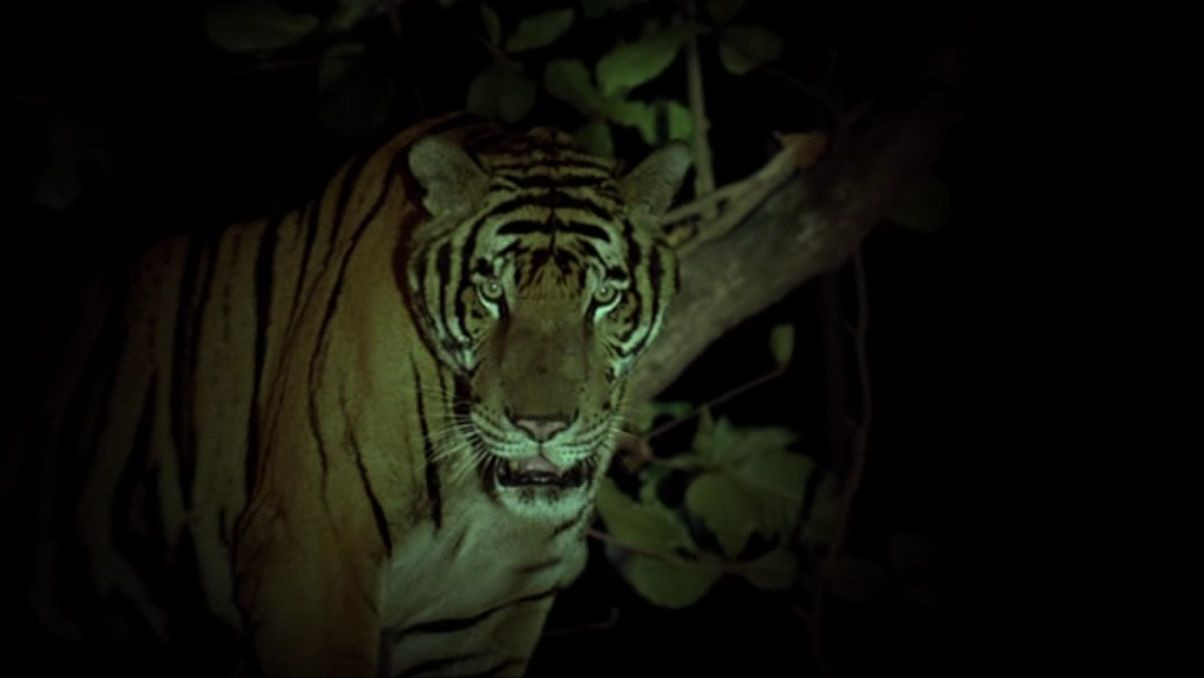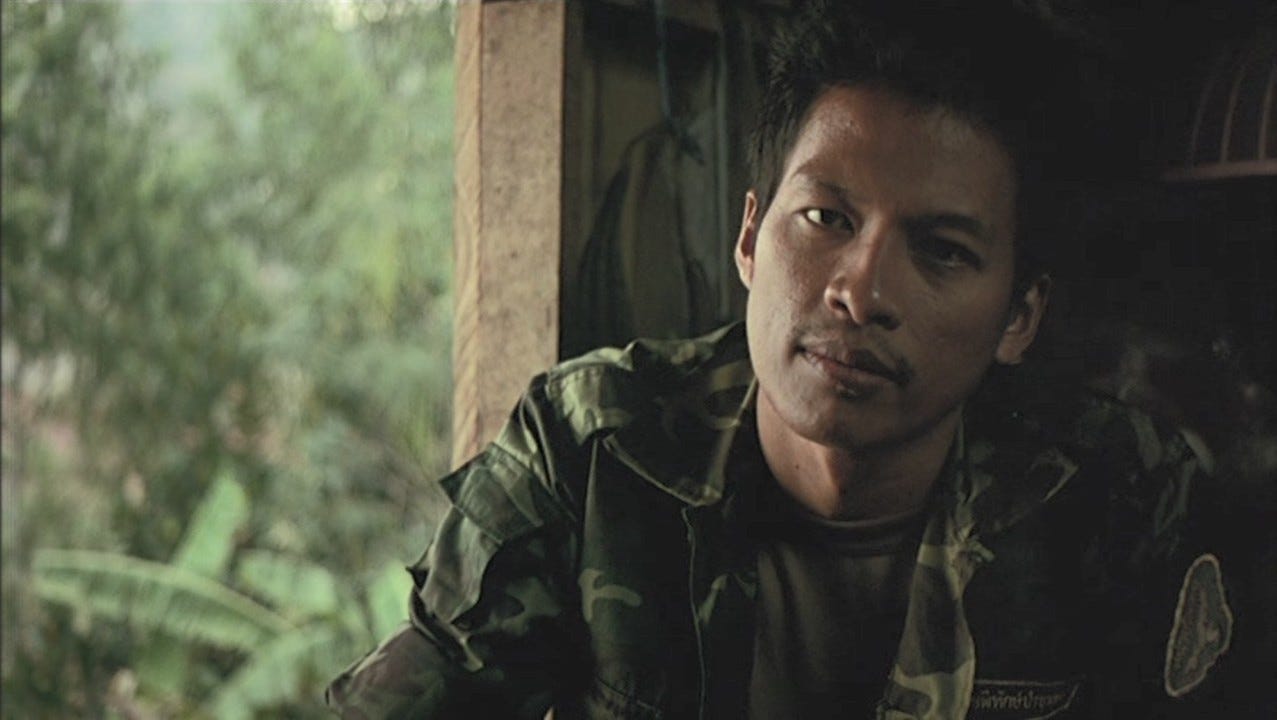Tropical Malady
Apichatpong Weerasethakul flirts with themes of essentialism in order to make a powerful, trembling exploration of the constructivist nature of our primal desires
In 2004, Thai filmmaker Apichatpong Weerasethakul premiered his feature film Tropical Maladay at the Cannes Film Festival to walkouts, booing and unfavorable reviews from the American press. However, in a twist of fate, the film earned the Festival’s prestigious Jury Prize and went on take make several reputable critics’ “Best of the 21st Century” lists. From rural Thailand, Apichatpong often situates his films in a struggle between the idyllic rural existence and the structured city life. Highlighting tangible contrasts in all his work (city/rural, past/future, young/old, etc.), he often directly bifurcates his films, splitting them into two loosely connected narratives, as he does with 2004’s Tropical Maladay.
In the first half of the film, we follow the budding romance of soldier Keng and rural boy Tong. The soldiers are stationed in Tong’s village, investigating the mysterious slaughter of livestock. This “half” of the film is shot naturalistically, yet with an essence of strict formalism, always alternating between the fluidity of handheld and static camerawork. The film’s second “half” begins just after Tong affectionately takes Keng’s hand to his mouth, licking it seductively, reminiscent of a feline. Tong saunters into the woods, not be seen again until the next “half.” The film’s second part opens with a folk drawing of a tiger and the title, “A Spirit’s Path.” Apichatpong briefly shows us the story of the tiger shaman, who shapeshifts in order to play tricks on travelers. When the tiger shaman, in the guise of a woman, attempts to lure a hunter, the hunter shoots the shaman, forever trapping him in his tiger body and leaving him to antagonize those who enter the forest. We then follow a soldier (played by the same actor who had played Keng) into the forest where he tracks a human-like tiger spirit (played also by the same actor who had played Tong). This half is also naturalistic, though nearly void of dialogue, immersed in the sonic world of the forest, and concluding with a fantastical, transcendental confrontation with the tiger spirit.
The film’s first half takes an ostensibly objective, realist position when following Keng and Tong’s romance. As audience members, we witness the frank, unembellished beginnings of love between two young men. This matter-of-fact portrayal subverts the hetero-normative tradition of cinema, as well as the more camp or dramatic methods of queer cinematic representation by looking past gender and binary sexualities and focusing more on the relationship itself. In this, Kong and Teng fit so well, so naturally, with each other and within their surroundings that they are radically de-queered. For example, Keng is often shown in military uniform, socializing with other soldiers — or with Tong and his family — but the stereotype of heterosexual masculinity and its “fundamental” bond to military aggression is dissolved in favor of a peaceful, relaxed depiction of smiling, affectionate, sexually ambiguous and nonjudgmental young men. By ridding this half of the film of any sort of coming out narrative or characters’ grappling with sexuality and gender in the face of cultural expectations, Apichatpong attempts to transcend this well-worn territory in favor of a deeper exploration of love between two people.
The film’s second half, “A Spirit’s Path,” explores the metaphysical and internal implications of the relationship. Again, this half deals less with issues of queer identity and sexuality as they relate to culture than it does with the essence of love. Here, Apichatpong has brought the characters away from culture and placed them into nature. He evokes primal nature, gradually chiseling away the soldier’s defenses so that he is left with nothing but his core self, face to face with the raw power of the tiger shaman. It would appear that such a core exploration of self in the absence of cultural and historical factors would argue from an essentialist point of view that if Keng’s doppelganger does indeed love Tong, then he must possess a fixed homosexual self. Yet, I would argue that the same could be argued about his essential heterosexuality if Keng were chasing a woman. It is helpful to step back and acknowledge Apichatpong’s dynamic, experimental and self-reflexive use of cinematic form at this point. Going back to the film’s opening credits, we are presented with a long, static shot of Keng in uniform, staring directly into the camera (at us, the viewers), bashfully flirting with us. Perhaps he stares at Tong just off camera, but, additionally, we the viewers are nevertheless implicated in his stare. This early demolition of fourth-wall structure sets us up as fundamental observers in the narrative of the film. So, when the soldier is alone in the woods, tracking the Tong-like tiger shaman in a primal, sexual hunt for the object of his desire, the backdrop of nature does not suggest a cultural vacuum, but, rather, it establishes a pristine, collectively recognizable slate by which to situate us, the already implicated culture, during a universal hunt we can all plainly identify with: retaining our sense of self in the bonding of a relationship. Apichatpong argues that we all struggle with this same conflict of self, regardless of the gender and sexual identity we bring into the forest from our different cultures.
The tiger shaman’s unfixed gender or species marks an important element of fluidity in the world of the film. At times, Keng is not even sure what it is he is tracking. As viewers, we see the tiger shaman as a folk drawing, a woman, as Tong and as an actual tiger. The ambiguous nature of Keng’s desire is reflected in the shifting essence of the tiger shaman. After stripping himself free from all cultural influence and discovering his self, alone under the moonlight, far from culture, Keng directly confronts the object of his desire as a powerful tiger. The scene is affecting, stirring and extremely moving. In this way, Apichatpong argues that Keng’s desire is too powerful and primal to contain within cultural boxes of gay, straight, male or female. Upon reaching the core of his raw self, face to face with such a fundamentally primal animal, Keng has come to understand his essence as an untamable, powerful, wild animal. No cultural restriction can neatly categorize it, and no cultural bias can purge this out of him. In this way, Apichatpong dangerously flirts with themes of essentialism in order to make a powerful, trembling exploration of the constructivist nature of our primal desires.
Films I Watched This Week
Collective (2019) directed by Alexander Nanau
Minari (2020) directed by Lee Isaac Chung
Wolfwalkers (2020) directed by Tomm Moore & Ross Stewart
Bloody Nose, Empty Pockets (2020) directed by Turner Ross & Bill Ross IV
Another Round (2020) directed by Thomas Vinterberg
Fourteen (2019) directed by Dan Sallitt
It Happened One Night (1934) directed by Frank Capra (rewatch)








